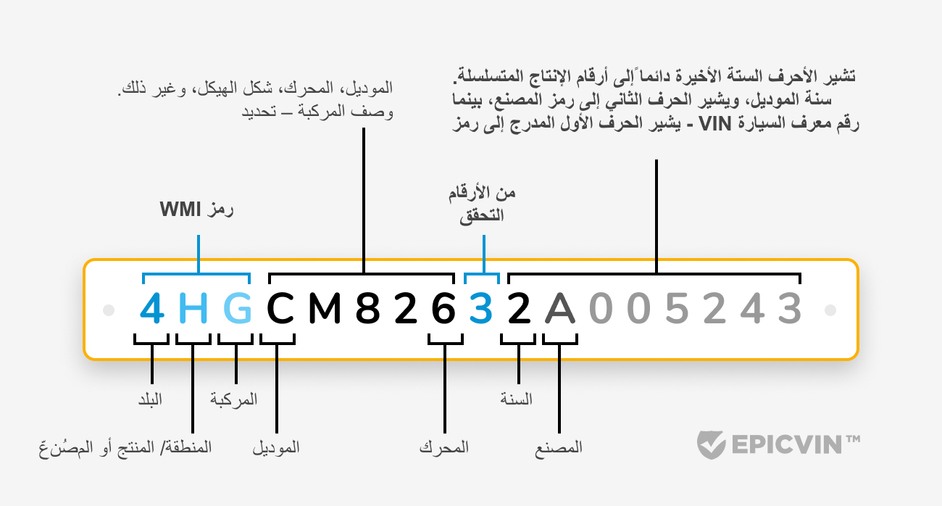
كيفية فك تشفير رقم VIN مثل المحترفين
بدءاً من فهم تفاصيل رقم VIN وصولاً إلى الكشف عن تاريخ السيارة، توفر لك هذه الم...

فك تشفير رقم الهيكل المجاني لسيارات Harley-Davidson! 🚗 اطلع على المواصفات وورقة البناء والاستدعاءات والتاريخ الأساسي - بدون تسجيل. 🛡️✅ تحتاج لمعرفة الحوادث والمسافة المقطوعة والسند؟ قم بالترقية بنقرة واحدة.
"هل تبحث عن VIN؟
سوف تجده هنا:

يمثل رقم هوية هارلي رمزاً فريداً مكوناً من ١٧ رقماً موحداً منذ ١٩٨١ من قبل معهد ISO. يتيح نظام أرقام تعريف المركبات هذا للمشترين التحقق من المواصفات والاستدعاءات والتاريخ من خلال فك تشفير رقم الهوية الخاص بنا قبل اتخاذ قرارات الشراء.
Follow these simple steps to decode any Harley VIN:

تعرض الدراجات النارية عادة رقم الهوية في عدة مواقع قياسية:
| المخاطر الرئيسية | التأثير على المشترين | خطوات التخفيف |
|---|---|---|
| خطر السرقة | ارتفعت الدراجات المسروقة بنسبة ١٢٪ على أساس سنوي | التحقق من رقم الهوية مقابل قاعدة بيانات السرقة NICB؛ تركيب جهاز تتبع GPS؛ التخزين الآمن |
| استدعاءات الأمان غير المُصلحة | حوالي ٨٢,٠٠٠ من طرازات Softail خاضعة للاستدعاء 25V-375 | تشغيل رقم الهوية من خلال فحص الاستدعاء NHTSA/EpicVIN؛ جدولة خدمة الوكيل فوراً |
| الانخفاض في القيمة مع الوقت | تنخفض القيم المستعملة بحوالي ١٥٪ في أول ٣ سنوات | شراء طرازات مستعملة بشكل خفيف؛ الاحتفاظ بسجلات الخدمة؛ الحد من التعديلات التجميلية |
| احتيال تراجع عداد المسافات | ما يُقدر بـ ٥٪ من القوائم المستعملة تُظهر أميال متلاعب بها | مقارنة مسافة رقم الهوية من NMVTIS وسجلات الخدمة والفحص |
| تاريخ الفيضانات أو الإنقاذ المخفي | حوالي ٦٪ من الدراجات ذات "السند النظيف" تم وضع علامة عليها لاحقاً | سحب تاريخ سند NMVTIS وصور المزاد من EpicVIN قبل الشراء |
قلل المخاطر: افحص رقم الهوية الخاص بك من خلال EpicVIN قبل الشراء للكشف عن التصفية السابقة وقراءات عداد المسافات والمكونات المستدعاة.
| المشكلة | الطرازات المتأثرة، الأعراض، متوسط تكلفة الإصلاح |
|---|---|
| تسرب حشية مشعب السحب | 1996–2001 Grand Marquis & Marauder V8، 80–130 ألف ميل (رائحة سائل تبريد، تباطؤ غير منتظم). 750–1100 دولار |
| عطل ناقل الحركة CD4E/CFT30 | 2005–2008 Mariner & 2003–2005 Sable 3.0L، 90–140 ألف ميل (تغيير قاسٍ وفقدان الدفع). 3200–4000 دولار |
| صدأ النوابض الخلفية والإطار الفرعي | 1996–2005 Sable & 2002–2007 Mountaineer، 100–160 ألف ميل (أصوات طقطقة وقيادة غير متوازنة). 900–1400 دولار |

كل رمز في تسلسل مركبتك الفريد يحكي قصة محددة.
هناك تفاصيل أخرى يجب أن يعرفها مالكو ومشترو هارلي:
إليك مثال على كيفية تفسير فكاك التشفير الخاص بنا لتسلسل عينة (1HD1BFV16FB019389):
| Symbols | Sample | What It Reveals |
|---|---|---|
| ١ | ١ | الولايات المتحدة كبلد المنشأ |
| ٢ | H | هارلي ديفيدسون كشركة مصنعة |
| ٣ | D | نوع مركبة دراجة نارية |
| ٤-٨ | 1BFV1 | رمز الطراز ونوع المحرك وفئة الوزن ونوع النقل |
| ٩ | ٦ | رقم الفحص للتحقق |
| ١٠ | F | سنة طراز ٢٠١٥ |
| ١١ | B | رمز مصنع التجميع |
| ١٢-١٧ | 019389 | رقم إنتاج المركبة الفردي |
عام 2010
طراز Harley-Davidson
موديل Street Glide
نوع الوقود Gasoline
محرك 1.6L V-Shaped Twin CAM 96
صنع في USA
الفحص الشامل يكشف تفاصيل الدراجة النارية المهمة:
EpicVIN تكتشف هارليز الاستدعاء المخفية قبل أن تشتري - مع وضع علامة على ٨٢ ألف Softail.Alex Black، CMO، EpicVIN
توجد على إطار رأس التوجيه، على جانب السائق، وأوراق التسجيل، وأحيانًا على غطاء المحرك لأغراض التحقق.
نعم، الرقم الأول ”1“ يؤكد أن المنتج أمريكي المنشأ، بينما يشير الحرفان ”HD“ إلى أن Harley Davidson هي الشركة المصنعة العالمية لجميع الطرازات المحلية.
تظهر حزم Factory Screamin' Eagle في رموز المحرك، ولكن تحسينات الأداء التي يتم تثبيتها من قبل الوكيل لا تظهر في مواصفات رقم تعريف السيارة (VIN).
الدراجات التي صنعت قبل عام 1981 كانت تستخدم تسلسلات أقصر بدون مواضع أرقام موحدة، مما يجعل التعرف على رمز الطراز أكثر صعوبة من الأنظمة الحالية.
نعم، تظهر طرازات التصدير رموز تعريف مختلفة للمصنعين العالميين ومواصفات أنواع المحركات لأسواق آسيا والمحيط الهادئ وأستراليا.
يظهر تسمية طراز الإصدار الخاص في رموز VIN خلال العام أو فترات الإصدار الخاصة لأرقام الإنتاج التذكارية.
أدخل رقم تعريف السيارة (VIN) في قاعدة بيانات NHTSA للتحقق من استدعاء 25V-375 الذي يؤثر على طرازات Softail والتحقق من حالة إتمام الإصلاح على الفور.
تحدد رموز المحرك في المواضع الرقمية 4-8 نوع نظام التبريد، حيث تستخدم المحركات المبردة بالسائل معرفات مختلفة لنوع المحرك.
هل يمكن أن يشير رقم تعريف السيارة (VIN) إلى ما إذا كانت دراجتي قد استخدمت في خدمة الشرطة أو أسطول المركبات؟
يوفر لك EpicVIN معلومات أساسية عن Harley فور إدخال رقم تعريف السيارة (VIN). يتم عرض التقرير الكامل للتاريخ مع سجلات الأضرار والحوادث في غضون ثوانٍ قليلة بعد الترقية.
اكتشف نصائح الخبراء والنصائح والأخبار حول شراء المركبات المستعملة وصيانتها.

بدءاً من فهم تفاصيل رقم VIN وصولاً إلى الكشف عن تاريخ السيارة، توفر لك هذه الم...

سنخبرك هنا بكيفية التفاوض عند شراء السيارات المستعملة

اقرأ هذه المقالة لاكتشاف كيفية حساب النسبة المئوية للضرر